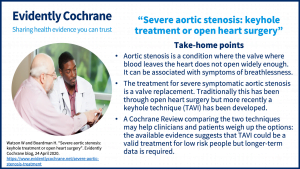In this blog for people with severe aortic stenosis and their families, cardiologists Dr Will Watson and Dr Harry Boardman look at the latest Cochrane evidence comparing two treatments for aortic stenosis in people with low surgical risk.
Page last checked 26 June 2023.
Take-home points
What is aortic stenosis?
Aortic stenosis is a condition where one of the valves which allows blood to flow out of the heart becomes restricted and stops working properly. Imagine a door through which blood leaves the heart which gets harder and harder to open. Initially the heart can compensate just by pushing harder to force the blood out of the heart but as the condition gets worse, not as much blood can exit the heart and travel around the body. This tends not to cause symptoms if mildly or moderately restricted, however if severely limited then it can cause physical restrictions and also reduce life expectancy. Initially, sufferers might notice that they can’t walk as fast or climb hills quite as steep without getting out of breath. Pain in the chest and blackouts can also occur. The strain of the heart trying to push blood through a smaller opening can make the heart muscle thicker and stiffer and eventually it can start to dilate and fail.

How is aortic stenosis treated?
There are no medications which help a hardened valve open more easily. There is no anti-limescale or engine oil for heart valves. A very restricted valve can lead to increased pressures within the heart which can in turn be associated with fluid accumulating in lungs and legs and water tablets (diuretics) can help remove this excess fluid, though they do not have any effect on the valve.
The only long-term treatmentSomething done with the aim of improving health or relieving suffering. For example, medicines, surgery, psychological and physical therapies, diet and exercise changes. for the underlying condition is to replace the valve. Traditionally this has involved open heart surgery (first performed in the 1950s). The chest is cut open, the heart stopped and the diseased valve cut out with a new one stitched in its place – this can be metallic or tissue (usually harvested from a cow or pig). Metal valves last longer but need blood thinning medication such as warfarin to stop blood clots forming on it.
Aortic stenosis typically causes symptoms in people in their 70s and 80s. Open heart surgery carries its own risks and the process of recovering from the surgery can be long. Typically, people stay in hospital for around a week but it usually takes months to build up strength and return to exercising normally. The riskA way of expressing the chance of an event taking place, expressed as the number of events divided by the total number of observations or people. It can be stated as ‘the chance of falling were one in four’ (1/4 = 25%). This measure is good no matter the incidence of events i.e. common or infrequent. of the operation relates to not just the valve problem but also fitness levels, other medical conditions and frailty. If people are particularly frail, elderly or have significant medical conditions they may not be fit enough for an operation, as they may be viewed to have an unacceptable risk of not surviving the operation. These people have traditionally been offered palliative treatment – medications to minimise the symptoms without the option of a definitive treatment.
TAVI – an alternative to open heart surgery
Transcatheter aortic valve implantation (‘TAVI’ or also termed transcatheter aortic valve replacement, TAVR) was developed over 20 years ago as a technique to replace the aortic valve with a keyhole surgery type technique. The new heart valve is mounted on a collapsible scaffold and often fitted around a deflated balloon. The collapsed new valve is passed to the diseased valve on the end of a wire, from a puncture into an artery (typically, in the groin) using X-ray guidance before the balloon is inflated to deploy it in the same place as the diseased valve which is stretched out of the way by the new valve. As the procedure is much less invasive (often under local anaesthetic), the recovery period is a lot quicker and people often leave hospital three days after the procedure and can be back to normal activities within weeks.

Producing a collapsible valve as good as the existing surgical valves and implanting it successfully have been the major challenges of TAVI. However as more TAVIs are implanted, experience in this new technology and technique grows and complication rates have fallen. There is much more experience with surgical valve replacements with many more years of safetyRefers to serious adverse effects, such as those that threaten life, require or prolong hospitalization, result in permanent disability, or cause birth defects. dataData is the information collected through research. than with TAVI, but experience with TAVI is growing. Initially it was only used for people who could not have surgery as they were viewed too high risk but as the technique has been refined over the years, there has been an increasing drive to compare it to surgery in intermediate and even low risk people to see if it could become a new standard of care. It is also appealing to certain people who are keen to avoid open heart surgery and have a quicker recovery.
Seeking evidence on TAVI versus conventional surgery
This Cochrane reviewCochrane Reviews are systematic reviews. In systematic reviews we search for and summarize studies that answer a specific research question (e.g. is paracetamol effective and safe for treating back pain?). The studies are identified, assessed, and summarized by using a systematic and predefined approach. They inform recommendations for healthcare and research. attempts to answer the question of how good TAVI is in people considered to be low risk – those who would be expected to have a low risk of death or complications from surgery.
The review authors looked at all trialsClinical trials are research studies involving people who use healthcare services. They often compare a new or different treatment with the best treatment currently available. This is to test whether the new or different treatment is safe, effective and any better than what is currently used. No matter how promising a new treatment may appear during tests in a laboratory, it must go through clinical trials before its benefits and risks can really be known. where people with severe aortic stenosis and low surgical risk were randomisedRandomization is the process of randomly dividing into groups the people taking part in a trial. One group (the intervention group) will be given the intervention being tested (for example a drug, surgery, or exercise) and compared with a group which does not receive the intervention (the control group). to either receive TAVI or conventional surgery and compared the risk of death, stroke and readmission to hospital between the two treatments. They also looked at the risk of other complications including heart attacks, length of hospital admission, needing a pacemaker, kidney injury and bleeding.
This is an important question as if TAVI was comparable or better then more people may be treated with this less invasive technique with quicker recovery.
What does the evidence tell us?
The review found four studies, including a total of 2818 people. They found there is probably little or no difference, in the short term, in risk of death, stroke, or heart attack between TAVI and a surgical valve replacement.
The risk of needing a pacemaker is probably higher with TAVI; the review authors calculated that for every seven people treated with TAVI there would be one extra person needing a pacemaker, compared with those who have had surgical valve replacement.
The authors are confident (as the evidence is rated as high-certaintyThe certainty (or quality) of evidence is the extent to which we can be confident that what the research tells us about a particular treatment effect is likely to be accurate. Concerns about factors such as bias can reduce the certainty of the evidence. Evidence may be of high certainty; moderate certainty; low certainty or very-low certainty. Cochrane has adopted the GRADE approach (Grading of Recommendations Assessment, Development and Evaluation) for assessing certainty (or quality) of evidence. Find out more here: https://training.cochrane.org/grade-approach) that TAVI was associated with a lower risk of kidney problems, atrial fibrillation and bleeding.
Those who had a TAVI may have a lower chance of needing to be readmitted to hospital, although the quality of data used to answer this question was considered to be low and it is possible that there is no difference between surgery and TAVI in the risk of readmission to hospital.
What about in the longer term?
All of these data only looked at the short term (mostly less than 2 years, although one studyAn investigation of a healthcare problem. There are different types of studies used to answer research questions, for example randomised controlled trials or observational studies. followed its patients up for up to 5 years) and the authors concluded that studies looking at how well patients did over many years were needed to paint a true picture of the risks and benefits between the two approaches. People who have lower surgical risk are on the whole younger, fitter and expected to live longer than those who have a higher surgical risk and therefore in this populationThe group of people being studied. Populations may be defined by any characteristics e.g. where they live, age group, certain diseases. long follow-up data are important to ensure that TAVI long term complication rates are no higher than conventional surgery: ensuring people are no worse off from this approach.
The bottom line
In these low risk patients there was no difference in the main outcomesOutcomes are measures of health (for example quality of life, pain, blood sugar levels) that can be used to assess the effectiveness and safety of a treatment or other intervention (for example a drug, surgery, or exercise). In research, the outcomes considered most important are ‘primary outcomes’ and those considered less important are ‘secondary outcomes’. of death or stroke. It is established that the typical recovery time after a TAVI is quicker than after a surgical valve replacement. However the long term safety data are yet to be established with TAVI and in low surgical risk patients this is of particular importance. Future safety data including more years of follow-up will be important in aiding clinicans’ and patients’ decisions.
People with severe symptomatic aortic stenosis may want to discuss the options with their cardiologist and factoring in their other medical conditions, their frailty and balancing their short and long term health priorities will be relevant to their decision making. It should also be noted that with this relatively recent technique the availability and waiting time to receive a TAVI is variableA factor that differs among and between groups of people. Examples include people’s age, sex, depression score or smoking habits. in different countries.

Dr Will Watson’s biography can be seen below.
Join in the conversation on Twitter with @DrWillWatson @harry9bo @CochraneUK @CochraneHeart or leave a comment on the blog. Please note, we cannot give specific medical advice and do not publish comments that link to individual pages requesting donations or to commercial sites, or appear to endorse commercial products. We welcome diverse views and encourage discussion but we ask that comments are respectful and reserve the right to not publish any we consider offensive. Cochrane UK does not fact check – or endorse – readers’ comments, including any treatments mentioned.
Reference:
Kolkailah AA, Doukky R, Pelletier MP, Volgman AS, Kaneko T, Nabhan AF. Transcatheter aortic valve implantation versus surgical aortic valve replacement for severe aortic stenosis in people with low surgical risk. Cochrane Database of Systematic ReviewsIn systematic reviews we search for and summarize studies that answer a specific research question (e.g. is paracetamol effective and safe for treating back pain?). The studies are identified, assessed, and summarized by using a systematic and predefined approach. They inform recommendations for healthcare and research. 2019, Issue 12. Art. No.: CD013319. DOI: 10.1002/14651858.CD013319.pub2.
Will Watson and Harry Boardman have nothing to disclose.




Hi. I wanted to know if I can choose just as my preference to have keyhole surgery as opposed to open heart surgery. I need a valve replacement and all I have heard is open heart surgery. I am 59 years old.
Hello Liz,
This is a question for your clinician, but I do hope the information in this blog might help with that conversation.
Best wishes,
Sarah Chapman [Editor]
My mother has severe aortic stenosis and is not considered to be a good candidate for the Tavi due to her kidneys starting to shut down and need dialysis but dialysis causes her blood pressure to drop and breathing to be labored due to the AS …can fix one or other she has also had a stroke 3 months ago and was doing well…. I just wondered are there doctors that would try this procedure on a patient like this to help them …. Fix the valve and dialysis is possible and may just jump start the kidneys…
Hello, thank you for this informative post. My mother (71) has severe aortic disease and requires her mitral and aortic valves to be replaced as part of open heart surgery. She is on Apixiban and has numerous other co-morbidities (CLL, Arthritis (taking methotrexate), diabetic).
She is apparently not eligible for TAVI, however this article states that it has almost equivalent benefits over open heart surgery, especially for more frail patients.
What would be the rationale that my mother is not eligible for TAVI? Or any other patient similar to her situation?
Thank you
Patients with problems of more than one heart valve often present a complex case, especially if there are additional problems with other co-morbidities. These cases are usually discussed in a multi-disciplinary team (MDT) meeting between multiple experienced surgeons and cardiologists to come to the best possible way of managing them, as it may make more sense to replace both valves at the same time in one operation rather than tackling each one individually. A TAVI would only treat the aortic valve and not address a problem with the mitral valve.
I have recently been assessed as having severe aortic stenosis. I am Stage 4 NSCLC and have a
Prognosis of about 3-5 years. It is inoperable. I have brain metastases.
I am interested in the stats which consider possible bleeding in the brain while on blood thinners ( Eliquis” if I am required to not commencing blood thinners after a TAVI.
Dear Marg Morris,
Thank you for your message. I’m sorry to hear about your diagnosis.
Anticoagulation (with Eliquis [also called Apixaban] or other agent) is not mandated after TAVI, unless there is another reason for anticoagulation (such as AF). Usual practice is single or dual antiplatelet therapy (aspirin +/- clopidogrel). A trial is ongoing which is testing if Eliquis is beneficial after TAVI (ATLANTIS trial, https://clinicaltrials.gov/ct2/show/NCT02664649). The original Eliquis trial (ARISTOTLE, https://www.nejm.org/doi/10.1056/NEJMoa1107039?url_ver=Z39.88-2003&rfr_id=ori:rid:crossref.org&rfr_dat=cr_pub%3dwww.ncbi.nlm.nih.gov) reported a rate of bleeding in the brain of 0.24% per year but I don’t think they included anyone with brain metastases and therefore this number is unlikely to be accurate for patients with this diagnosis. I do not think any trial testing the benefit and safety or any anticoagulant has included patients with brain metastases.
I cannot offer any advice or guidance on what treatment you should or should not have and you should have a conversation with you doctor(s) about this, however on the information you have provided I would have concerns that with a diagnosis of stage 4 non-small cell lung cancer with brain metastases that a TAVI may not offer much benefit.